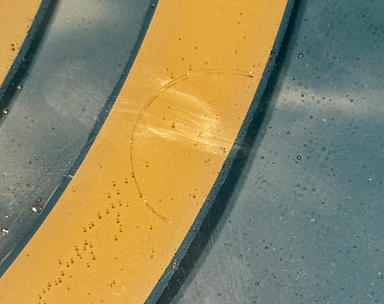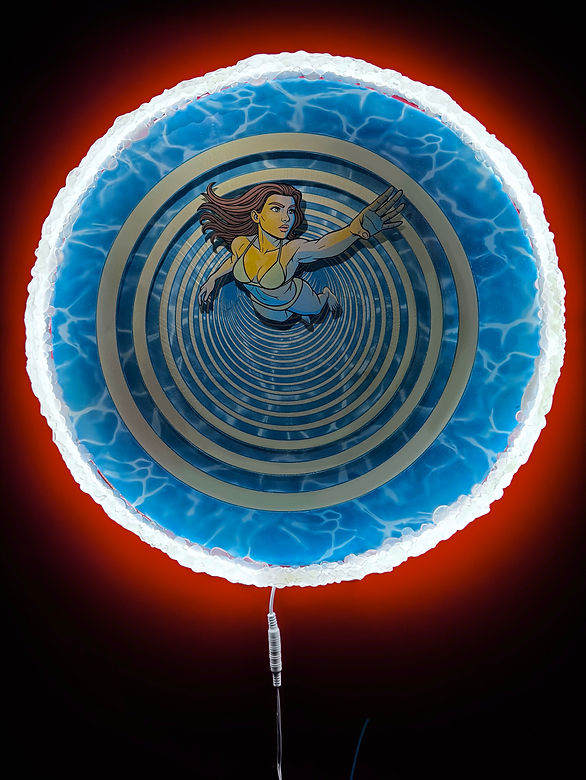

01
Where to start?
I began by drawing concentric circles. To me, this tunnel-like effect provided a narrative. Where are we going? What's in there? That sense of mystery intrigued me.
02
Who is the subject?
The subject I imagined was the ideal woman—an embodiment of strength and grace. I made her beautiful but also imagined that she was striving for something greater than herself.


03
What is the mood?
I went through several iterations before deciding on a background.
At first, I imagined her flying, but that felt too supernatural. Water, on the other hand, created a peaceful atmosphere while also suggesting pressure, which heightened the sense of struggle.
04
How am I going to print this?
I don't own a printer. They're the worst.
But I do know a guy. He's the best.
Thank you to Jan at Lecuit in Luxembourg. He made me a perfectly color matched, even print to take home. These are huge prints, which even the best printers struggle to reproduce with consistent quality and accuracy.


05
How am I going to cut it out?
Each layer was printed on a different paper because I planned to cut them out. Scissors weren't going to do the job, so I bought a blade that does 360-degree turns.
If only Jan had known—he might not have stressed so much about getting that blue perfectly flat and even. (Sorry, Jan!)
06
What was I thinking?!
Whenever you try something for the first time, you risk getting it wrong. And, boy, did I get it wrong with epoxy resin.
Mistake #1: Heating the resin and hardener too much
I’d read that warming the bottles in a hot water bath makes the contents less viscous and helps it mix more evenly.
The problem is that when you get it too hot (like I did), the resin starts curing way too fast—releasing strong fumes and even starting to smoke.
All I could do was open all the windows and pray I hadn't poisoned myself.


Mistake #2: Using a toothpick to remove air bubbles
I really underestimated how many air bubbles would form in the resin. Casting paper made it even worse—air would get trapped underneath and slowly rise to the surface.
Every time I checked, new bubbles had appeared, and once the resin began to harden, they became stuck before I could remove them.
Unfortunately, this totally ruined the look of the piece.
Still, I pressed on—channeling my inner Thomas Edison, determined to learn every wrong way first so that eventually I’d get it right.
Mistake #3: Underestimating dust and debris
Even though I carefully cleaned the space and warned my husband to stay far away from my work area, tiny particles still found their way onto the resin surface, becoming sealed inside like little time capsules.
Many, many years from now, long after I'm dead and gone, several of my hairs will still be perfectly preserved.


07
How can I improve?
Lessons were learned, new equipment was purchased, and I tried again.
08
What if I added LEDs?
I really wanted to illuminate the piece somehow. Light is inherently hopeful, and I imagined it shining through the layers to enhance the depth.
However, when I tested the light facing inward, it actually flattened the layers. In the end, I turned the light outward toward the frame, which created a softer glow


09
How do you sculpt water?
I considered a few different ways to make the frame look like liquid.
My first idea was to sculpt water splashes with translucent polymer clay, but I felt it would clash too much with the drawing.
Instead, I wanted something that could layer and drip naturally, without appearing too controlled or manipulated by human hands.
In the end, I used hot glue, which created organic, flowing drips that felt closer to real liquid. Since I knew hot glue wouldn’t adhere well to non-porous surfaces, I completely encased it to hold everything in place.
10
Should I add anything to the frame?
I loved the way the glue looked. It was perfectly translucent—hiding the LED strips while refracting just enough light to create a glowing effect.
But I wanted to see if I could push it a little further, so I added a touch of pigment to the surface.
I was careful not to use so much that it blocked the light—just enough to give it a subtle sparkle when the lights were off, and an extra shimmer when they were on.

The Final Result

